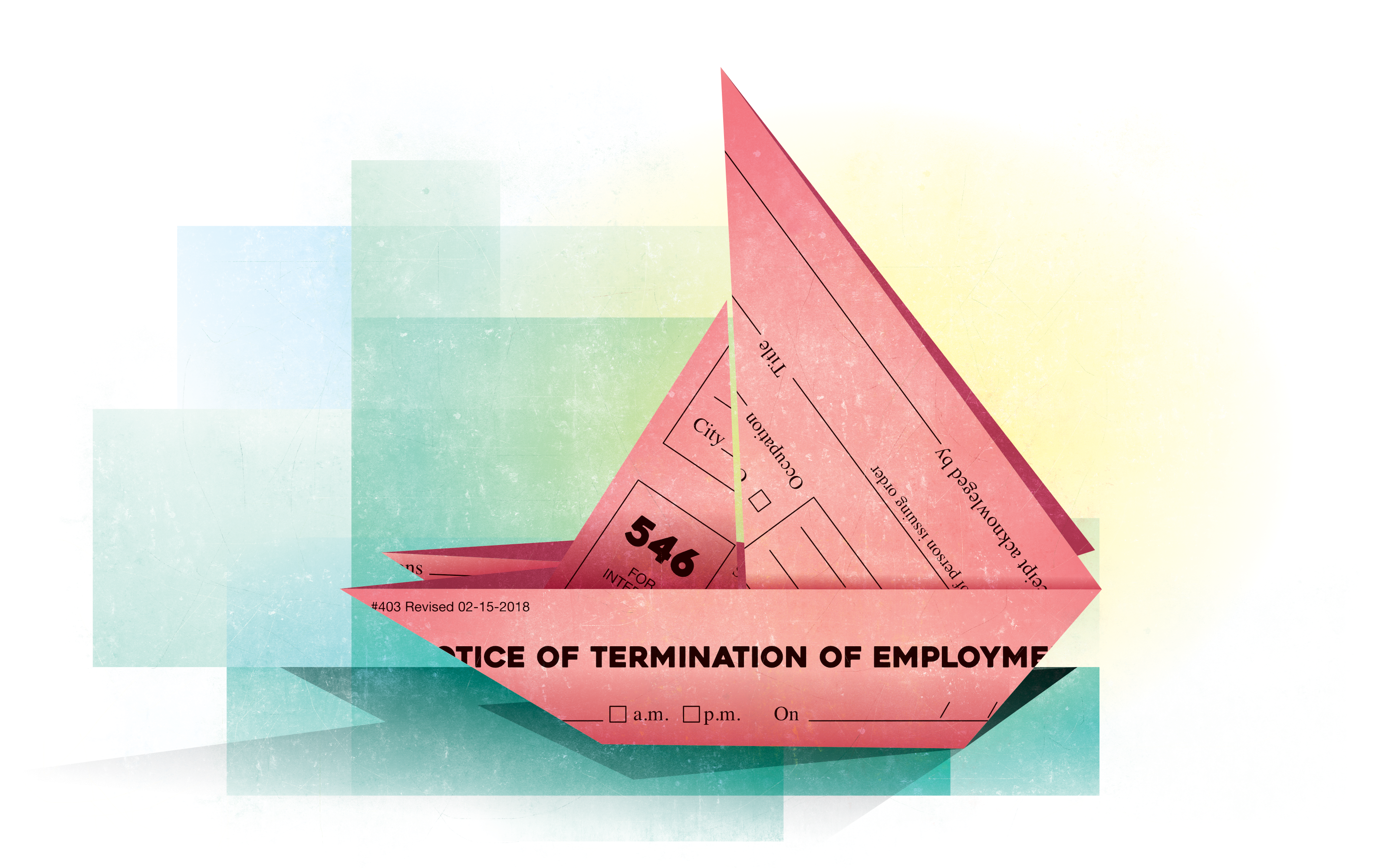
After your organization has made the difficult decision to fire or lay off an employee, less is often more when it comes time to deliver the news, some experts say.
“The termination interview is not the time for discussion and justification,” says Melanie Peacock, SHRM-SCP, an associate professor of business at Mount Royal University in Calgary, Alberta, Canada. Instead, she counsels human resource professionals to simply say, “The decision has been made. Effective immediately, your employment is terminated.”
“Say the same thing over and over again,” Peacock advises. “At first, I thought that was rather inhumane. But it’s more compassionate by making it quick.”
You may think employees know what’s coming, she says, but they are often surprised when they’re terminated. Even when they’re working under a performance improvement plan or have faced progressive discipline, she adds, “it still takes them aback.”
Mark Kluger, founding partner at law firm Kluger Healey LLC in Fairfield, N.J., agrees that termination meetings should be brief and should not include many details.
“Often, an employee wants an explanation,” Kluger says. But he advises HR professionals “not to go down that road. You may say something that you later regret.”
Dennis Theodorou, who has conducted terminations in his role as managing director at JMJ Phillip Executive Search in Troy, Mich., has a different take. He recommends allowing employees a chance to express their feelings. “There might be something that you could learn from it,” he says.

‘The termination interview is not the time for discussion and justification.’
Melanie Peacock, SHRM-SCP
First, Work to Avoid Termination
Not needing to terminate an employee is always preferable, and efforts to make workers valuable contributors to the organization should start when employees are onboarded, experts say.
New hires should have a clear understanding of job expectations, says Michael Timmes, SHRM-SCP, a consultant in Freehold, N.J., with Insperity, which provides HR solutions.
“Organizations with clear, well-communicated workplace policies avoid misunderstandings,” explains Timmes, who is also program chairperson for the Jersey Shore Association for Human Resources chapter of the Society for Human Resource Management (SHRM) and co-director of membership and director-elect for Garden State Council-SHRM.
Policies should be reviewed with staff periodically so all employees understand the organization’s best practices and expectations, which can help prevent situations from going awry, he says.
Some organizations are quick to want to terminate someone, Timmes says, instead of looking at it as being the last resort. Try to address any shortcomings in performance through additional employee training and development, he suggests.
If an employee is being terminated for performance issues, “I never want to surprise somebody,” Theodorou says. “I think terminating someone on the spot is the worst thing you can do. They should understand why they are being terminated.”
The decision to terminate an employee should be made only after other options have been exhausted, agrees Tashia Mallette, SHRM-SCP, chief people officer at SAG-AFTRA (Screen Actors Guild-American Federation of Television and Radio Artists) in Los Angeles.
“We want to be sure we’ve done everything we could on our side for the employee to feel supported in the work environment,” she notes, such as using a performance improvement plan if there is a skills gap. “We give them the benefit of the doubt and the appropriate resources to make them successful.”
If major weaknesses are identified, a performance improvement plan or progressive discipline structure should be established and documented so everyone knows what needs to improve and by when, says Vanessa Matsis-McCready, associate general counsel and director of HR for Hollywood, Fla.-based Engage PEO, which provides HR outsourcing solutions.
After receiving the performance improvement plan, the employee should demonstrate “immediate and sustained improvement,” she says. “You never want to have a sunset to the improvement.”
If the employee’s performance doesn’t improve, Matsis-McCready advises, HR professionals should talk to the individual before deciding to terminate them. “There may be circumstances you’re not aware of that would change your next steps,” she says. “You don’t want to get new information in the termination meeting.” For example, the employee could be caring for a sick relative or have children at home during a school closure.
Documentation of the issues can provide some protection if things sour, Matsis-McCready says. “It helps you evaluate if a termination is warranted,” she explains.
It’s important for HR professionals to be consistent with termination decisions and to avoid the appearance of bias or favoritism toward certain employees. Otherwise, you could be opening yourself up to discrimination and wrongful-termination complaints.
Timmes recommends following the precedent set by past decisions. If you aren’t consistent, he says, be prepared to explain what is different this time and why.
Keep in mind that if someone has received input on their need to improve but fails to do so, you could be doing them a favor by terminating them, according to Kluger. “Nobody wants to feel unsuccessful at work,” he says. A termination “gives them an opportunity to find something they may be better at.
Advance Planning
Once you decide to terminate an employee, take time to prepare for the meeting, advises Peacock, who noted that terminations were often required due to restructurings and reorganizations when she worked in the oil and gas industry.
She recommends checking the employee’s personnel file to make sure the termination doesn’t take place on their birthday or work anniversary.
“There’s a lot of conscious, deliberate, compassionate planning” that needs to happen, she says.
An HR professional or the employee’s manager should determine the best place to have the conversation. If the company elects to pack up the person’s belongings and have them delivered, Peacock recommends meeting somewhere other than the employee’s office. That way, it’s easier to get the employee to leave once the meeting ends.
At least two employer representatives should be in the room when the meeting is held so there is a witness to the conversation for legal and safety reasons, Peacock says.
It can help to hold the meeting in a room with two doors or to sit near the door so you can exit quickly if security concerns arise, says Landon Jones, senior security advisor at Burns & McDonnell, a consulting firm based in Kansas City, Mo. If you’re concerned about safety, he says, have a security guard present or bring in an off-duty police officer.
You should also notify your information technology department so they can quickly shut off the employee’s access to your organization’s technology network, Kluger says.
Before some termination meetings, Kluger has held role-playing sessions with managers or HR professionals so they’re better prepared to handle contentious situations.
If an employee who is being terminated accuses a manager of being racist or misogynist, for example, “you’ve got to be a blank slate and not react to it,” he says. Advance preparation can help with this.
Termination Considerations
HR experts recommend that practitioners keep the following points in mind when handling a termination:
- Allow opportunity for improvement. Set up a performance improvement plan or progressive discipline structure, and document everything.
- If an employee is being fired for cause, investigate the issue so there are no surprises at the termination meeting.
- Treat all employees consistently.
- Be aware of potential legal issues. If the employee has filed a workers’ compensation claim, taken leave under the Family and Medical Leave Act, filed a discrimination complaint, or complained about a safety or wage issue in the past six months, consult with legal counsel before deciding to terminate employment to avoid possible retaliation claims.
- Develop a plan in advance. Determine the meeting location, arrange to have someone else present as a witness, and line up security if you’re concerned about safety.
- Create a termination checklist. Identify what you need to get from the employee, such as keys and codes, and what they need to take with them, such as personal items.
- Role-play the termination discussion beforehand, and consider how you will handle different scenarios. Will you allow the employee to say goodbye to colleagues? Who will accompany them?
- Keep the meeting short and to the point. Avoid lengthy conversations so you don’t say something you might regret or that could be used against you in court.
- Remain calm and collected, and convey compassion.
- Provide information on topics such as severance packages, outplacement services and employee assistance programs.
- Contact IT immediately to remove the employee’s access to company software and e-mail accounts.
- Share the news. Notify the rest of the team in a professional and respectful manner without divulging personal employee information.
- If there is any indication that the terminated employee will seek an administrative proceeding or lawsuit, don’t respond until you have obtained legal advice. —S.L.
What to Say
Jodi Standke, CEO of Talon Performance Group, a talent management firm based in Minneapolis, says the termination conversation should be short and to the point. “Mistakes are made when the message is given within a larger conversation,” she says.
Most states have at-will employment, so employers don’t need to explain why they’re firing someone, Standke says. “Most of the time, the employee knows,” she adds, although “they might not want to admit it.”
By having a lengthy discussion, Standke notes, you run the risk of saying more than you should, or of having the employee misconstrue what is said or argue about the decision.
“If an employee feels attacked or not respected, they are more likely to retaliate and seek legal recourse,” she says.
It’s also possible the employee will record the conversation, Kluger warns, so if you react to what is said and say something regrettable, “it may get played back to a jury.” (In many states, only one party has to agree to an interaction being recorded, so the tape would likely be admissible in court in the event of a lawsuit, Kluger says.)
Many organizations inform an employee at the termination meeting that they will receive severance pay, which could help soften the blow, Kluger says. But if the employee is disappointed by the amount, tensions could escalate.
He recommends telling the employee that the organization is still determining the amount of severance and that the money will be sent to their home the next day. “You want them to behave themselves on the way out,” he says.
Heather Younger, an HR consultant and author of The Art of Caring Leadership (Berrett-Koehler, 2021), says empathy and understanding are key in these conversations. She advises HR professionals to “step into the shoes of the person.”
She recalls being laid off from an organization after a merger. When her manager delivered the bad news, she says, “I felt cared for. I could sense he was deeply hurt.”
During the termination meeting, provide information about topics such as how the employee can collect their belongings and receive their last paycheck, Standke says.
If the employee asks about these matters and no plan is in place, Peacock recommends simply saying, “Arrangements will be made.”
“If you genuinely care about people and are thoughtful and deliberate, that will come across,” she says.
Peacock cites an instance in which she had to terminate a senior manager. The manager got up and hugged her afterward and said, “Are you OK? I know this must have been very difficult for you.”
Giving an employee the chance to speak up might be beneficial for an HR professional because the feedback might help you continue to develop your hiring and firing process, Theodorou says.
Terminating Remotely
Even before the COVID-19 pandemic pushed many people into working remotely, some organizations that already relied on a remote workforce had to regularly conduct terminations virtually or by telephone, Matsis-McCready says.
In the wake of the pandemic, more HR professionals and managers may be facing such challenges, and it’s important to maintain protocols that are similar to those you have in place for in-person terminations.
Better.com, an online mortgage lender, -received a raft of negative media coverage when its CEO, Vishal Garg, terminated 900 employees via a Zoom call in December. He was placed on leave but returned to his duties in January. A number of executives resigned from the company in the wake of the call.
Kluger recommends that a remote reduction in force be handled via individual private meetings, with time set aside later for follow-ups.
If a termination is taking place remotely, Peacock says, someone else from the organization should still be on the call or virtual meeting to serve as a witness. Additionally, the employee should be given advance notice that a private meeting is necessary so that no children or other family members are present during what is typically an emotional conversation.
“It’s hard enough under normal circumstances,” Peacock says.
Legal Concerns
If you’re conducting a reduction in force, you should consider who is being let go and why, Timmes says.
It might be that the organization is moving in a new direction or that certain employees’ skills don’t fit with a new product line. However, if a majority of the people being terminated are over the age of 40, you might be inviting legal claims. “If you’re not careful, it could be part of an age discrimination violation,” Timmes warns.
Beth Langley, a partner in the Greensboro, N.C.-based law firm Brooks Pierce, says that if an employee has filed a workers’ compensation claim, taken leave under the Family and Medical Leave Act, complained about a safety or wage issue, or filed a discrimination or harassment complaint in the previous six months, you should consult with legal counsel before deciding to terminate their employment.
Safety and Security
If you’re concerned about an employee who is being terminated turning violent, determine in advance how to defuse any potential threats, says Landon Jones, senior security advisor at Burns & McDonnell, a Kansas City, Mo.-based consulting firm.
Jones recommends forming a team and being proactive. That includes contacting your in-house security staff or a local law enforcement agency to have an officer present at the termination meeting.
“No one just snaps and turns to violence,” Jones says. Instead, there are warning signs to look for. These include:
- Indications that the employee has a sense of injustice or a perceived wrong.
- Erratic, unsafe or aggressive behavior.
- Threatening speech or gestures.
- Social isolation.
- Being a target of hazing or bullying.
- Self-harm.
Just because an employee exhibits one of these behaviors doesn’t mean they’ll become violent if they’re terminated, but Jones cautions that these are important factors to keep in mind as you plan for a termination meeting. —S.L.
Offer Support
Standke recommends not firing someone on a Friday because they will have limited access to unemployment resources and career transition services over the weekend. “It just puts them into a spin,” she says.
By providing information on benefits and unemployment to workers being terminated, SAG-AFTRA works to “support their offboarding as much as we did their onboarding,” Mallette says.
If an employee is a good worker but isn’t the right fit for the organization, Mallette and her team may even help the individual look for new job opportunities or provide them with positive references.
It can be helpful to have someone else available as a resource for the employee, such as an outplacement counselor, says Buck Rogers, vice president at Keystone Partners, a Boston-based talent management company.
Rogers recalls a client who had to let an employee go after 20 years with the company. The organization made outplacement benefits available to the individual, and Rogers was there to offer him assistance navigating the job market.
Initially, the employee said he wasn’t interested in the help. But the next day, he met with one of Rogers’ career consultants to start his job search.
Bringing in a third party can help assure the terminated employee that it’s going to be OK, Rogers says.
Rogers himself was laid off from an organization a decade ago. “It knocked the knees out from underneath me,” he says.
Those who lose their jobs often wonder what they will tell their family, friends or new employer. “Sometimes people need help with that,” he adds.
When it comes time to terminate an employee, it’s best to remember the golden rule, Rogers says: “How would you like to be treated if it happened to you?”
Susan Ladika is a freelance writer based in Tampa, Fla.
Illustrations by Traci Daberko.

